INTRODUCTION:
One of our friends called it Yogya, the hotel staff called it Jogya, the locals there called it Jogja and Jogjakarta, there could be another permutative name for this wonderful city on the foothills of an active volcano on the island of Java in Indonesia. When we first heard about this hidden gem, we researched online and found mixed reviews and a few good photographs; but we assure you that photographs simply do no justice to this city. This city of students has an air of excitement and liveliness that it is hard to resist enjoying yourself here. The houses here have been constructed in a very distinct style and the walls are decorated with beautiful graffiti based on a plethora of topics from politics to abstract art. If you want to experience Javanese culture and traditional arts, if you want to stay away from the hordes of tourists and want to experience old-world charm, the city of Yogyakarta, in the special region of the same name, is the place to be.
HISTORY:
The region of Yogyakarta has had a long history of rulers and dynasties, starting from the Mataram kingdom in the eighth century followed by the Majaphit empire around the thirteenth, to the Mataram sultanate of medieval times, the Japanese occupation of the second World War and to eventually gaining a special-kingdom status in Indonesia after independence. The crux of Yogyakarta’s mythology is centered around an active volcano, Mt. Merapi, which is dangerously close to the city. Merapi means ‘Giving Fire’ in the local
language. As scary as it may sound, the Javanese worship the volcano as a life-giver because of the fertile soil that is has provided them with, for agriculture. In fact, the first agricultural settlers of this region may have probably chosen this region due to this soil. There are villages as high as 5600 feet on the slopes of the volcano itself.
There are two versions of history of the period between sixth and eighth centuries, but what we do know for sure is that the Medang kingdom was ruled successively by Buddhist (Sailendra) and Hindu (Sanjaya) rulers. They were great patrons of architecture and the temples of Borobudur and Prambanan built by them stand testament to this. The Sanjaya rulers were ardent followers of Shaivism which is a form of Hinduism which reveres the Hindu god, Shiva, as the supreme being.
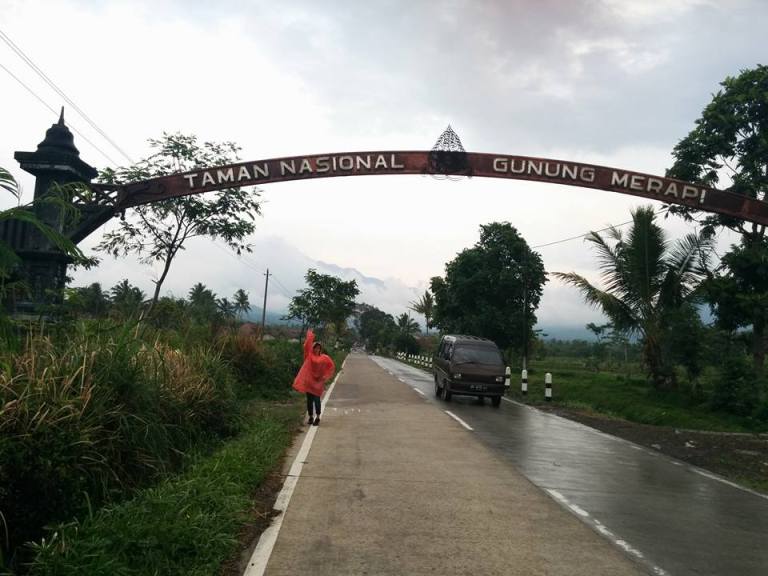
BEST SEASON TO VISIT:
Indonesia is humid and so is Yogyakarta, you could pick any month of the year and it would not matter, it would still be humid. It rains very frequently and quite unpredictably too, but rain does not hamper anything at all here and is in fact a welcome relief after the sun . The best time to visit would be between March and September with the prices of accommodation and the hordes of tourists rising in the months of July and August.
HOW TO REACH:
Yogya is accessible by flights from other major locations in Indonesia and a few places abroad. We chose to travel by train as we were coming in from Jakarta and also because we wanted to have that experience. Choosing a night train may save a lot of time, but it also means you have to choose the right type of train so you don’t end up staying awake all night. Various low-cost carriers such as Batik Air, Lion Air and Citilink are available if you want to travel to Yogya. As for train travel, you can book tickets here.
Tip: Most Indonesian trains do not have a berth/sleeper facility which means you have to spend the entire trip sitting or reclining. Also, trains do not have any proper facility for luggage storage except small racks atop seats.
ACCOMMODATION:
Have no second thoughts, just book a room at The Grove Express. You will be thanking us for suggesting this place. The hotel is excellent in every aspect, from courteous and helpful staff to clean rooms which are easy on the pocket, this hotel was the best that we had ever stayed at.
LANGUAGES SPOKEN:
Obviously, all people in the tourism industry are well-versed in English, but once we got off the main grid, we noticed that few people were comfortable with English; we had a lot of fun trying to speak the local tongue – Bahasa Indonesian. People were very appreciative of the fact that we were making an attempt at speaking their language and were very helpful.
FOOD:
There is a lot of street food-a hell lot of it actually; fried seafood dominates the roadside stalls. It was not easy finding vegetarian food, save Tofu, and we settled for a little bit of dessert and lots of fruits. The hotel staff were very helpful, they specially cooked vegetarian food for us every morning and even packed us some to go. A sweet dish made of jackfruit or Gudeg called Yogya Gudeg was simply delicious and can be found at many roadside stalls, we highly recommend this.
Tip: Many innocent-looking dishes contain shrimp; we had a few fritters only to be told later by someone that a few fritters that were pink had shrimp in them. Vegetarians better watch out for these.
TRANSPORT:
From rickshaws to chauffeur-driven cars, Yogya offers a lot of options in transport. There are infrequent, but cheap buses that charge you a fixed amount to anywhere in the city. For intra-city travel, it would be useful to get the Grabtaxi app, but the service was slow as there were very few drivers. It is not the most reliable of options available. A chauffeur-driven car is a good option as it is not very costly, but there are fixed packages for each tourist-spot and most of the people that we talked to were not very interested in a full-day package. Note that many of the famous tourist spots are away from the city. We hired a two-wheeler and decided to explore the city ourselves. Yep, we had no idea what we were thinking, but the idea seemed fun and we just went with it. If the weather is right, this is a good option; it cost us 200,000 IDR for one day and fuel set us back by 40,000 IDR.
While in Indonesia, it would be worthwhile trying out the Rickshaw for covering small distances. It is quite pitiful to see them pedalling out under the hot sun, but they are a cheerful lot and take pleasure and pride in what they do; they refuse a tip, but will gleefully accept a soda-can.
SIGHTS AND PLACES TO SEE:
With two UNESCO World Heritage Sites, Yogyakarta offers a plethora of options for the enthusiastic traveller – a touch of traditional Indonesia, close-up action of an active volcano, age-old temples for the architecture-loving, street graffiti for the artistic and an entire market to hone one’s haggling skills. We decided to start our tour with a visit to the Kraton, which is inside the city itself; the Kraton is the palace of the Sultan of Yogyakarta and his family, who reside here to this day. The palace complex also houses a museum that displays the artefacts of the Sultan and also the traditional costumes worn by the royal family during important occasions.
We were met by scores of vendors and guides before we could even attempt to buy the ticket (which cost us IDR 15,000 per person) as they lined up in front of the palace. We chose a quiet guide who was also an attendant at the palace; we found out later that Lonely Planet had featured him as the ‘Puppet-man’ of Yogyakarta as he had a personal collection of more than 700 puppets. He told us at length about the people of Yogyakarta, their customs and how they regarded the Sultan as a semi-divine being. He was not very good with historical information, but was well-equipped with information about the customs of the Sultan and the Kraton.
Tip: Be sure to ask your guide for a badge before you pay them, there are many locals who roam around the palace pretending to be guides.
But we did find this online about the palace: The Kraton dates back to the 18th century and was built by the first Sultan of Yogyakarta region, Hamengkubuwono-I, who fought and won against the Dutch East India Company to claim the territory of Yogyakarta. But, most of what we see today is a result of the reconstructive work undertaken after the region was hit by an earthquake in 2006; the palace has undergone significant change since then. There are exhibits that depict the various ceremonies of the royal family, such as Crowning, Bridal Shower, Marriage, Circumcision and Death among others, with life-size models in traditional attire worn during each event.
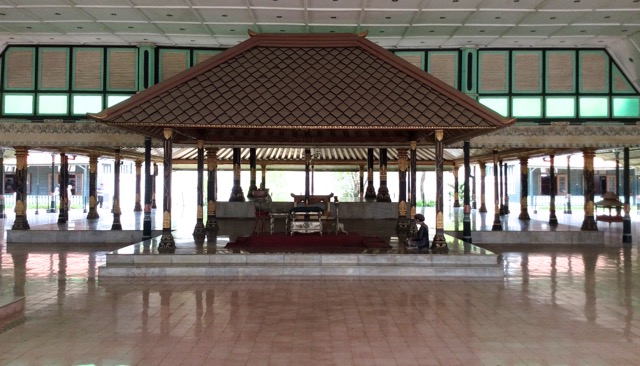
The residential chambers are out-of-bounds for visitors and only a lucky-eye may catch a glimpse of the royalty when they appear. The area surrounding the crowning ceremony stage has been cordoned off to prevent visitors from damaging the gold-laced pillars and beams; our guide explained to us that the pillars were once made of gold and laced with precious stones and that many visitors scraped the pillars to collect the gold or at least its dust.
Tip: Do remember to check out the shows at the Kraton beforehand, there is very little information available online though.
We finished our tour and then proceeded to the Sonobudoyo museum, but, it was closed for some repairs. Our guide then took us through a series of narrow lanes to a local Batik painting centre which was being run by him. We normally avoid going to such places, but we saw there were other tourists too, and so we followed him. The Batik place turned out to be surprisingly good, but we found the products a tad bit expensive compared to ones at India. It was extremely humid and we were refreshed ourselves with a few local beverages before we proceeded to Taman Sari or Water Palace. Taman Sari, a World Heritage Site, is very near to the Kraton and we recommend that you take a rickshaw for the fun of it.
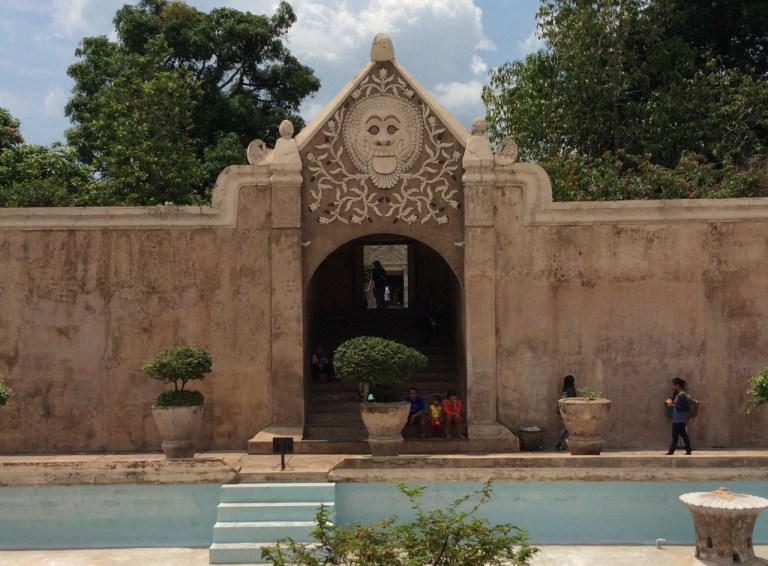
Built by the same emperor as a retreat of sorts, it was a pleasure-house that contained parks, gardens and pools, some of which were underground. It even housed an underground mosque, the dome of which is still intact after the earthquake and decades of negligence, which is accessible only by an underwater passage. There are underground tunnels which are actually escape routes that lead to nearby places. These underground structures add to the air of mysticity surrounding this palace; the palace feels like an abandoned ghost-palace. The loss of many of these structures due to earthquakes and neglect led to the declaration of this site as an Endangered Site by the World Monument Fund in 2004. Ever since then, there has been a turnaround as restoration work has started.
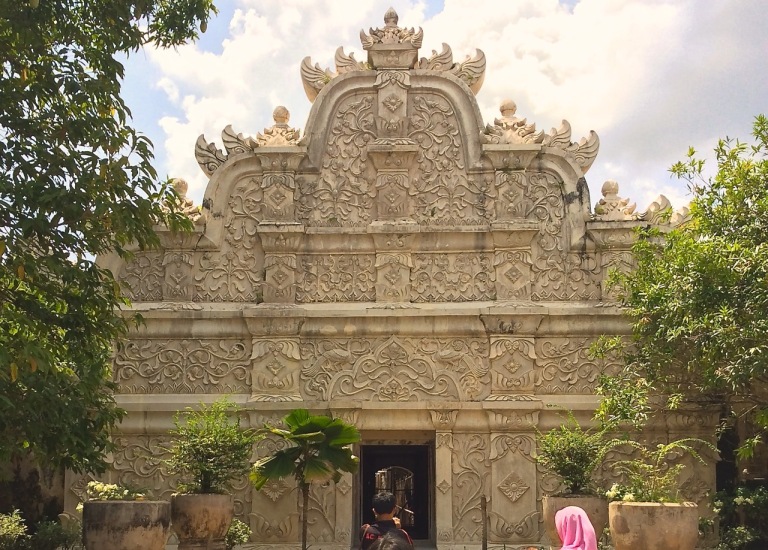
Tip: Take time to explore this place and definitely hire a guide; you may miss out on a couple on underground passages if you do not explore in detail. Also, be sure to carry lots of water as there are no facilities inside.
We ended our first day with a tour of Jalan Malioboro (Malioboro street), the shopping hub. Be sure to check out this market that sells items at very affordable rates. This place is bustling with people, each trying to strike a good bargain, which brings us to bargaining – Do bargain here, just for the fun of it. We wanted to scoop up many of the handicraft items, but there was a real issue with the packaging and our baggage-limit.
Tip: If you are heading to Jakarta, shop for ‘clone’ or ‘first-copy’ items at Jakarta, you are sure to get a better bargain than at Yogya. But, if you are looking for handicraft items, then Malioboro street is the way to go. Also, stuff in Indonesia is not exactly cheap when compared to what we get at India.
It is not just the streets that are lively and brimming, the walls too, are, with graffiti. These street walls represent the spirit of the city as they cover topics from current affairs to political memes. Spend enough time looking at a wall and eventually a local may walk up to you and explain the meaning of the graffiti. We came across graffiti in and around Malioboro street, especially on the streets leading up to Jalan Prawirotaman which is where cafe Milas is located. Milas cafe is the place-to-be, it has great food that is cooked from the scratch, great ambience in that it is set in a garden, good service in that the staff is friendly and the best part is that it is affiliated with an NGO that is into sustainable social development. After a day’s travel, a few card games here would be the best way to wind down before you get ready for a new day.
Famous spots around Yogya can be clustered into two circuits – one on the east side that contains the temples of Sambisari, Prambanan, Ratu Boko, Plaosan, Sewu, Ijo and the Prambanan ballet; and the other on the north side that contains Borobudur temple and Mount Merapi.
The eastern circuit can be started from Yogyakarta by Jalan Raya Solo with a stop at Candi Sambisari (Sambisari temple). This Hindu temple complex built during the time of the ancient Mataram kingdom (not necessarily by the rulers) was buried underground and forgotten over the centuries until 1966 when a farmer accidentally discovered this site while ploughing his patch of land. There was large-scale excavation as the temple was buried under six and a half metres of sand and volcanic ash from Mount Merapi; the active volcano is visible from this site on a clear day. And from what we learnt from the people at this site is that further excavation is expected, although presently there is a shortage of funds. We felt that they should have charged more than the IDR 10,000 per person that they collected if they needed more funds. They also definitely need to market this place as a few locals were not aware of this place which is so close to the airport and on the same road as it.
Further excavation in the 70s led to the unearthing of many artefacts that furthered the understanding of the temple; sadly, one of the prized artefacts – a statue of Mahakala – was stolen and all that remains now is a picture of the statue on the information board at the site.
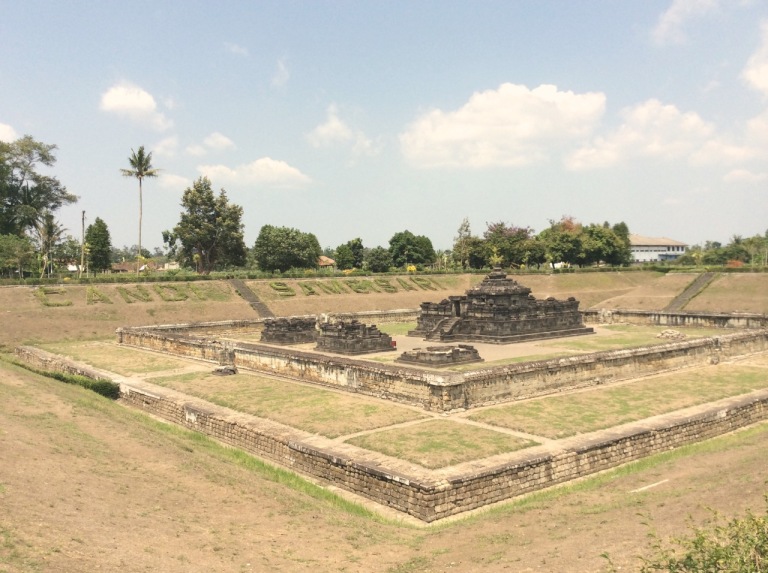
The main deity here is the Hindu god, Shiva housed in the Linga form in the main temple. Although the base of the main temple is accessible by a flight of stairs leading downwards, the temple by itself is on an elevated pedestal, similar to the ones at Khajuraho. The entrance is small and one has to bow in order to enter the temple, a design on purpose, perhaps? Once we got up the stairs and into the temple, we noticed that there was space around the sanctum for circumbulation that was covered by balustrades. The walls are adorned by statues of Agastya, Durga and Ganesha, all important characters in Hindu religion and mythology.
There are three other smaller temples, but they seem either incomplete or in ruins with missing roofs and platforms. We suppose they are incomplete as there are empty spaces that look like they had been prepared for temple foundations. This entire complex is surrounded by two boundary walls with a lot of space between them which we suppose was occupied by the shops surrounding the temple.
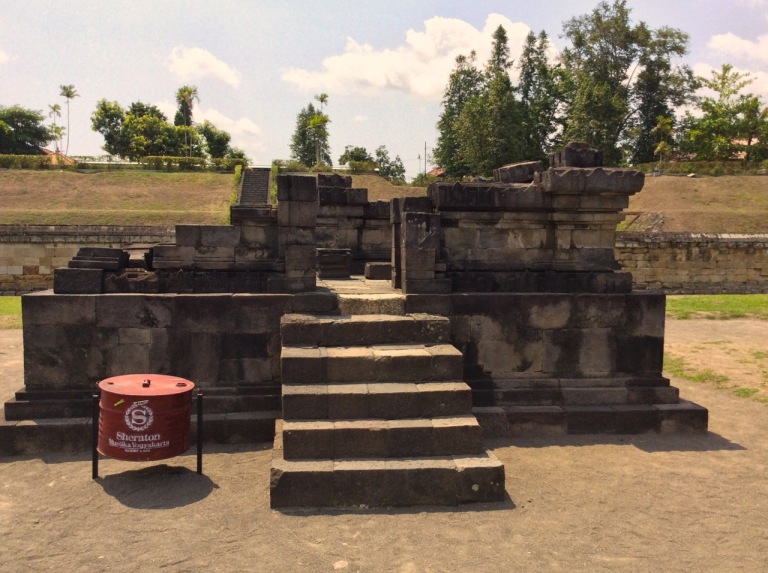
Further down the road is the Candi at Kalasan, followed by Candi Sari. From what we had read, we understood that these temples were similar to the UNESCO heritage temples of Prambanan and Borobudur and so we spent our limited time at these places; did we tell you that we were here on our honeymoon? And there was no better way to celebrate our honeymoon than watching a ballet, the Prambanan Ramayana Ballet, to be specific.
Before you reach the temple of Prambanan, there are posters that direct you to the office of the Ramayana Ballet counter. Be sure to check up with your hotel about the schedule, there are Ballets throughout the year. You can check the schedule here. Depending on the weather and time of the year, there is either an outdoor performance or an indoor one. The outdoor one has the Prambanan temple as the backdrop.
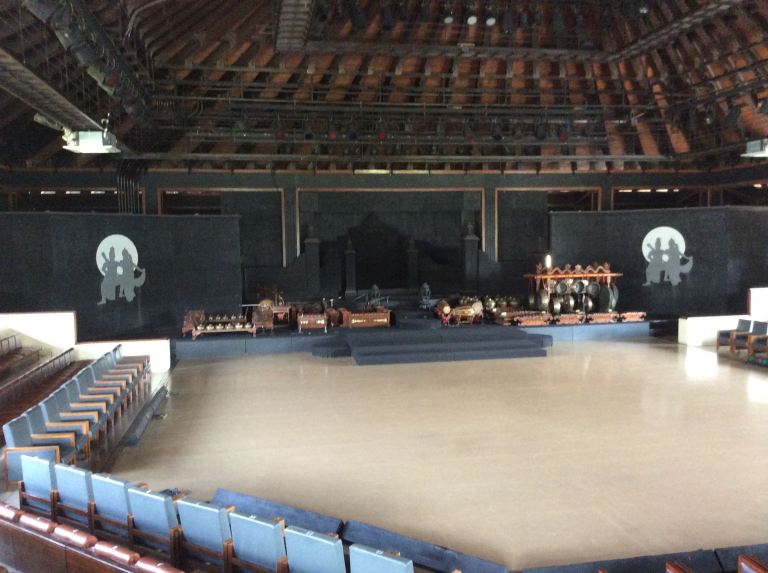
Tip: Watch only the authentic Prambanan Ramayana Ballet, there are many more such shows, but this is the only authentic one. To be assured of a ticket, you will need to book at least two days in advance, you could couple the booking with a trip to Prambanan too.
The two-hour long ballet brings to life the Ramayana, a Hindu epic. The actors dancing to the tune of a Gamelan portray the life of Rama, the prince of the kingdom of Ayodhya, starting from the Svayamvara of Sita when he marries her to when he is banished from the kingdom to the forest and his struggles in the forest to the battle at Lanka where he fights Ravana when he abducts Sita. The ballet encompasses all elements of the Javanese culture and music; the theme, Ramayana, has been modified to suit the Javanese culture as the Indian version differs significantly from this one.

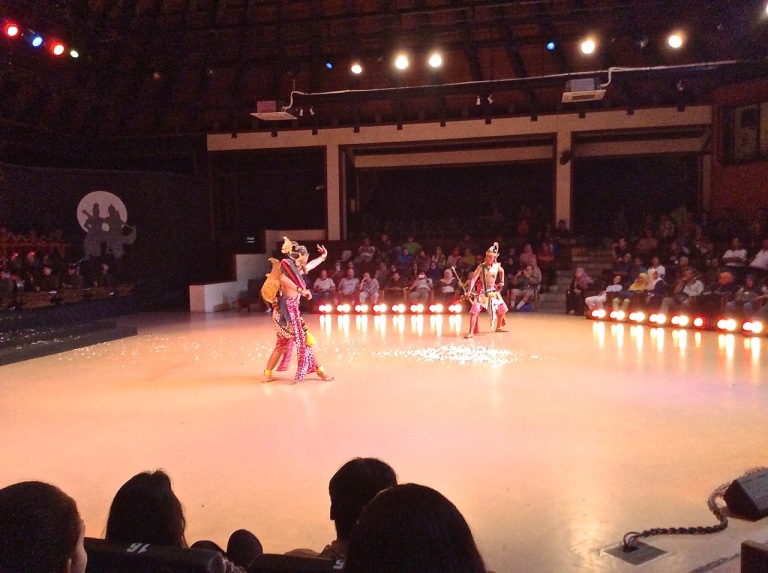
The next stop is the temple-incarnate Prambanan, we visited Prambanan after we booked the tickets to the Ballet that was scheduled for the next day. The Prambanan temple complex consists of the main temples at Loro Jonggrang; Candi Lumbung, Candi Bubrah and Candi Sewu nearby; Candi Ratu Boko, Barong, Banyunibo, Abang in the Ratu Boko complex; and Candi Plaosan, Sojiwan and Ijo in the vicinity of these complexes. It is no wonder that this is the largest Hindu temple site in Indonesia.
The UNESCO World Heritage Site fame Prambanan temples at Loro Jonggrang were built some time in the 9th century by the rulers of the Sanjaya dynasty of Mataram kingdom, perhaps as an answer to the Buddhist temples of Borobudur and Sewu built by the Sailendra dynasty which was previously in power. Their inclination to Shaivism explains the fact that of more than 250 temples at the complex, the biggest and most majestic temple at Loro Jonggrang houses an idol of Shiva.
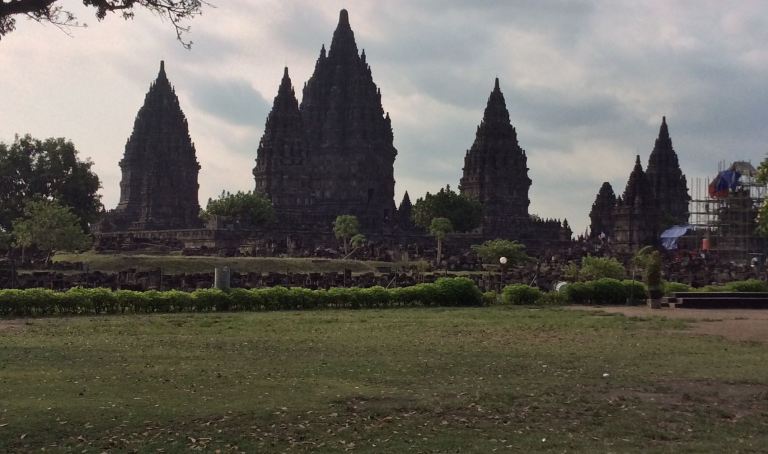
The complex of Loro Jonggrang (or Roro Jonggrang) has a legend to its name, one which is not as old as the temple itself. Legend has it that a Javanese princess by the name of Roro Jonggrang was the heart-throb of a prince named Bandung Bondwoso. Roro hated Bandung as he had killed her father and was opposed to their union, but the prince persisted nevertheless. Fearing the prince, Roro finally agreed by setting two seemingly impossible tasks for the prince to accomplish failing which she would not marry him. The first was for him to build a well ‘Jalatunda’; the prince, with an army of spirits at his disposal, finishes the task within no time and displays his work to Loro who asks him to enter the well. She then tries to kill him by sealing the well with stones, but the prince manages to escape this trap and goes back to her for the other task. The other task was to build a thousand temples in a single night which seemed more impossible than the first. Not so for the prince, who finishes all but one of the thousand with the help of spirits that he conjures up from the earth. The princess realises this and asks her maids to light a fire in the east and begin pounding rice; rice-pounding is an activity traditionally performed at dawn.This misleads the spirits into thinking that the sun is about to rise and they return to the ground before completing the last temple. In a fit of anger, the prince turns Roro into a stone statue and so, Roro herself becomes a part of the final temple, completing the last temple and fulfilling the second condition for their marriage. And thus ends the legend of Roro Jonggrang or the legend of the ‘Slender Virgin’. In reality though, there are only 240 temples at the complex, of which, fewer than 30 are intact after the earthquake of 2006.
The entry ticket to Loro Jonggrang for Indonesians is 70,000 IDR and foreigners is 240,000 IDR. There are various combo-tickets that you can choose for entry to the temples at Borobudu, Sewu and Ratu Boko and we suggest that you go for the combo-tickets as they are worth it. As are other places at Yogya, the entrance is swarming with guides who are trying to guess your language and impress you with their humour as you walk by.
Tip: If you are well-versed in Hindu scriptures such as the Ramayana, it is better that you not hire a guide as the guides explain a lot about Ramayana and Krishnayana which has been depicted through sculptures on the walls of the temples.
When one enters the Loro Jonggrang complex, one is greeted by the boards with pictures of the site, before and after the restoration work carried out by the Indonesian government. The three main temples here are dedicated to the Hindu gods Shiva, Vishnu and Brahma, also known collectively as the Trimurti. Each of these gods has a Vaahan or vehicle and fascinatingly, in this complex, each vehicle has been built a separate temple.
Thus ends our first post on Yogya, our next episode in continuation to this, details our experiences at Prambanan and Borobudur and also our time at Merapi.
#daringbadi
REFERENCES:
http://whc.unesco.org/en/list/642/
http://www.newworldencyclopedia.org/entry/Sailendra



Wow. Excellent description.
Have you ever considered writing professionally? There are a lot of companies that pay you to do that.
LikeLiked by 2 people
Haha, thank you for the suggestion, yes, we would be interested in doing something like that.
LikeLiked by 1 person
Well hopefully someone sees your blog and recognizes the potential – you truly do detailed and interesting journaling of your travels. I’m first time visitor and loved both this and Khasi Hills post!
LikeLiked by 1 person
Your comment just made our day. Such comments of encouragement make us want to write more and better. Thank you so much and keep visiting our blog.
LikeLiked by 1 person
Nice, I like it a lot … 🙂
If you’re interested check out our blog 😉
LikeLiked by 2 people
Thanks, we also checked out your blog and it was a really different one. Good luck with your blog and happy travelling.
LikeLiked by 2 people
Cool article,. I was always gonna visit Indonesia and Yogyakarta with its volcano is quite famous. Thanks for the info, this shud be enough to get me started.
Which place do you recommend for Backpackers in Yogya?
Cheers and thanks!
LikeLiked by 2 people
Hi Chris, thank you. I would recommend any of the hostels near Gadjah Mada university.
LikeLiked by 1 person
So thankful that your blog popped up when I searched about Yogyakarta. I liked the pics and the writing. Candi Sambisari was not on my watch-list, but I am checking it out for sure now.
LikeLiked by 2 people
Thank you Tom. Sambisari is a very good place, somewhat overshadowed by Prambanan and Borobudur.
LikeLiked by 1 person
The more I read about the old kingdoms of the south east Asia more I want to do my bucket list history trail trip of Indonesia and Cambodia! Yogyakarta is just so beautiful and rustic and still not commercialized. I really feel people should promote this place more, and you have done an exceptional work and making people wonder about this old royal city 😀
LikeLiked by 2 people
Yes, you are right, this place is not commercialised and has managed to retain its charm despite the influx of tourists. We have not yet written about Borobudur and Merapi, we would be adding to it very soon. Thank you for stopping by.
Cambodia is on our bucket list too.
LikeLiked by 1 person
Hey, do you blog too? We could check out your blog. 🙂
LikeLiked by 1 person
Looks like an interesting place to visit!
LikeLiked by 2 people
Thanks Jenn.
LikeLiked by 1 person
Good to know to travel in the shoulder season. Indonesia looks incredible! If I go, I’ll be sure to pack my rain jacket!
LikeLiked by 2 people
Yep. A rain jacket is a must, and you can find one anywhere in Indonesia. Rain seems a part of their life and does not disrupt the lives of the locals a bit.
LikeLiked by 1 person
Awesome post. Very informative. thanks for the helpful tips.
LikeLiked by 2 people
Thanks a lot, Pia.
LikeLiked by 1 person
I’ve been to Indonesia so many times, but have only seen Bali. I’m really hoping to branch out to some of the other islands in the coming years, especially Java. Seeing the temples in Yogyakarta is on my list! Bookmarked this for future reference when I finally make some travel plans.
LikeLiked by 2 people
Bali was way too mainstream for us, we read a little about Yogyakarta and instantly fell in love with the city, and it did not disappoint us at all.
LikeLiked by 1 person
That’s such a useful guide and well structured. Really helpful to plan a trip to Yogya! Thanks 🙂
LikeLiked by 2 people
Thanks a lot, Nadine. 🙂
LikeLiked by 1 person
Wow! It looks like an amazing place! Awesome and informative post 🙂
LikeLiked by 2 people
Thanks a lot Ellie. Yogya is a great place to visit. Thanks for stopping by.
LikeLiked by 1 person
Hey lovely post. Have added this on my bucket list of must see places. Check out our blog too. Amrita
threeflaneurs.wordpress.com
LikeLiked by 2 people
Thanks a lot.
Sure, we will check out your blog too.
LikeLiked by 1 person
wowww look amazing ı thought that that buildings cant believe this world
LikeLiked by 2 people
Yes, the world is an amazing place. 🙂
LikeLiked by 1 person
This sounds like the kind of place that my family would love to visit
LikeLiked by 2 people
Yogyakarta is a very good choice as a family destination.
LikeLiked by 1 person
Wow I’ve never even heard of Yogya! Your post has been a great way to learn about this place…thank you!
LikeLiked by 2 people
You are welcome. Thanks for stopping by.
Yogya is kind of underexplored and somewhat unappreciated too.
LikeLiked by 1 person
This is an interesting read. I like how in depth your article is, and well written too.
LikeLiked by 2 people
Thanks a lot, it is not complete though. We will be completing it very soon.
LikeLiked by 1 person
Will be a while before my family will be able to take a trip like this since I have three young kiddies, but based on this, I DEFINITELY have to add this to my bucket list!! 🙂
LikeLiked by 2 people
If you have three kids, then a trip to Merapi would be awesome. Trust me, as a kid, I had always wanted to see a Volcano and would even dream of it.
LikeLiked by 1 person
woww how they built that amazing buildings really look amazing 🙂 thanks for share them
LikeLiked by 2 people
Yes, quite a wonder.
LikeLiked by 1 person
what a wonderful and magical destination! I love how you incorporate tips! Very useful indeed!
LikeLiked by 2 people
Yes, indeed.
And every tip that we have written has some touch of personal experience to it.
LikeLiked by 1 person
Such a great post packed with info another place to add to the list lol xxx thanks for sharing
LikeLiked by 2 people
Thank you for stopping by.
LikeLiked by 1 person
This is really nice, and a lot of useful information to take in. I love the pictures too.
LikeLiked by 2 people
Thanks for stopping by.
LikeLiked by 1 person
I love reading about other parts of the world. This was a great post, and awesome pictures. Thank you!
LikeLiked by 2 people
Thanks for stopping by!
LikeLiked by 1 person
Wow, that’s super nice that the hotel staff packed food for you. I’ve been to a lot of hotels and I haven’t seen that thoughtful gesture before. Congrats on your amazing looking honeymoon!
LikeLiked by 2 people
The hotel staff pampered us. If we had to choose the best hotel ever that we had stayed in, it would definitely be this.
And about the honeymoon, this was a stop before we headed to Bali and Rantepao. Amazing indeed!
LikeLiked by 1 person
Ohh I love this. Next time I am in the area I am visiting here. Love love love
LikeLiked by 2 people
Hehe. It does make for a great family vacation.
LikeLiked by 1 person
What a fascinating place! Those monuments are incredible.
LikeLiked by 2 people
Yes, we are in the process of completing the second part of this post.
LikeLiked by 1 person
Beautiful post with detailed description. I was not knowing this place but after reading this I would like to visit due to ancient hindu temple and culture.
LikeLiked by 2 people
There is more to this place than just Prambanan and Hinduism, there is Borobudur which is a Buddhist temple. We will update the details of this place too. Stay connected to our blog.
LikeLiked by 2 people
Sure
LikeLiked by 2 people
WOW, what a marvelous place!! I want to visit. Love your photography too btw
LikeLiked by 2 people
Thanks a lot, Farah.
LikeLiked by 1 person
NICE ARTICLE.. LOVE THE PICS
LikeLiked by 2 people
Thanks a lot.
LikeLiked by 1 person
Really great post and informative, good writing too. I love the roro complex photo so beautiful. Thank you for the information.
LikeLiked by 2 people
Do stay tuned for the extension of this post about Borobudur.
LikeLiked by 2 people
I love to visit all this place. Good post
LikeLiked by 2 people
Very nice and detailed post on Yogyakarta as I was not knowing about it. It really looks very cultural and ancient.
LikeLiked by 2 people
Yogya is all about culture and ancient tradition, do keep following us for more blog posts.
LikeLiked by 1 person
Really well written! A pleasure to read! Indonesia was already on my wishlist for quite some time and I guess it made the top 3 now! So in love with Asia!
LikeLiked by 2 people
Thanks, hope India is on your list too. Check out our posts on Indian off-beat destinations.
LikeLiked by 2 people
Wow this is an amazing post, loaded with some great info on Yogya- a place I have never heard of till now. Fabulous tips and love the way you tried to incorporate local habits in your travel there.
LikeLiked by 2 people
Thank you Shalini. Yogya is kind of underrated, but deserves a lot more, this post is not complete BTW. Do stay in touch with our blog for further updates.
LikeLiked by 1 person
Have to say it’s such an explanatory guide on Yogyakarta, I am planning to visit Bali but if I could team up it with Yogyakarta I would definitely do that, specially after reading your blog I have an urge to go there.
LikeLiked by 2 people
Trust us when we say that Yogya would excite the seasoned traveller more than Bali would. And we have not covered a couple of other places of Yogya such as Mount Merapi and Borobudur.
LikeLiked by 1 person
I’ve always been amazed by the Asian culture. Unfortunately it’s a not that easy to travel to such places, hopefully people can re-leave your experience by reading such posts. Thank you!
LikeLiked by 2 people
Yes, it is a not-so-easy to travel place, but then, is that not the point of travel, to experience something that we have not experienced before?
LikeLiked by 1 person
This place looks absolutely amazing! I don’t know very much about places to see in Indonesia, but I’ll definitely make this a stop when I get to visit the country.
LikeLiked by 2 people
You will definitely not be disappointed.
LikeLiked by 1 person
Thanks so much for the thorough information! I’m a sucker for UNESCO sites, so that is a big draw for me, and your photos are beautiful. What a fascinating area!
LikeLiked by 2 people
We try to be as helpful and thorough with the info, thank you for visiting.
LikeLiked by 1 person
Wow, it makes me yearn for Yogyakarta even more…
LikeLiked by 1 person
Thank you so much mam, your comment is special to us. 🙂
LikeLike
I love your post! Thank you! My next trip will be to Indonesia and this post is what I need 🙂
LikeLiked by 1 person
Hi Mirela,
Thank you for your comment. But, please do visit our new website as this blog is not functional anymore. Thank you.
LikeLike
What an exhaustive guide. I love the fact that information is from Indian perspective Which is not easy to find on net
LikeLiked by 1 person
Thank you. This is the first part actually and was written much before we knew what SEO was and how to apply it.
About Yogya, we find that Indians usually skip Yogya when visiting Indonesia, sticking to Bali and surroundings.
PS: Do visit our website unboundoutbound.com too.
LikeLike
Ah. I’ll check that out too 😊👍
LikeLike